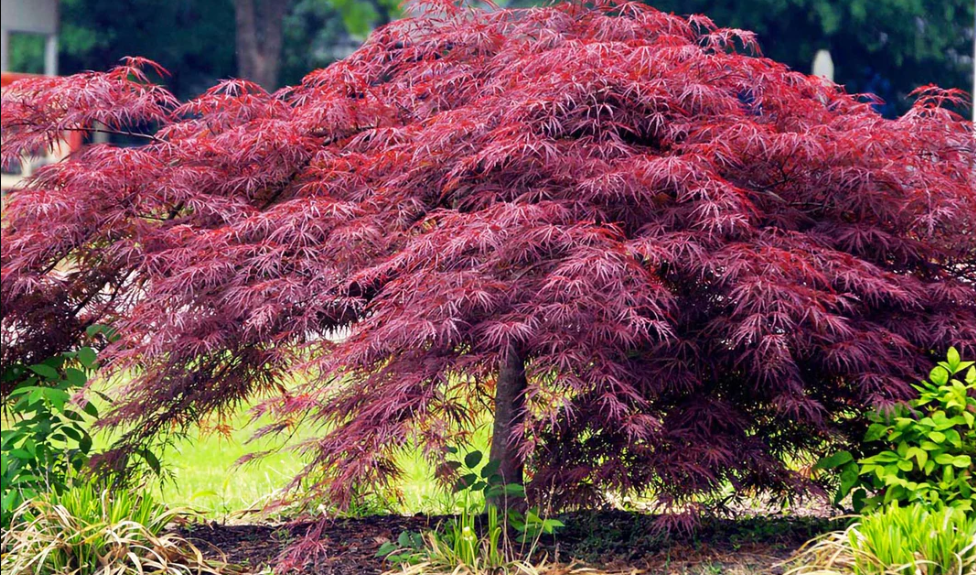
Crimson Queen Japanese maples, scientifically known as Acer palmatum var. dissectum ‘Crimson Queen’, are a popular cultivar of the Japanese maple family. This particular variety has finely dissected leaves with persistent color throughout the entire growing season, unlike many other Japanese maples that change color or fade over time.
Japanese maples have been cultivated in Japan for over 300 years. They were brought to Europe and North America in the 1800s. Today, Crimson Queen Japanese maples are widely available in nurseries and garden centers across the United States and are often used in landscaping
The Crimson Queen Japanese maple is a medium-sized deciduous shrub or small tree that grows to 10-25′ (infrequently to 40′) tall. It is native to Japan, Korea, and China. The Crimson Queen variety specifically is a much smaller, rounded, slow-growing form that rarely matures to more than 12′ tall with a larger spread.
These maples are noted for their weeping growth habit and cascading branches. They are relatively easy to grow and care for, preferring well-drained soil and partial shade. With proper care, a Crimson Queen Japanese maple can live for decades.
These trees are hardy in USDA Hardiness Zones 5 to 9, which means they can tolerate a wide range of climates. In Zone 5, the Crimson Queen Japanese maple can withstand winter temperatures as low as -20°F to -15°F. In Zone 9, it can handle winter temperatures as high as 20°F to 25°F.
Crimson Queen Maple Tree Characteristics
- Crimson Queen Japanese Maple has finely dissected leaves and weeping growth habit.
- It is a medium-sized deciduous shrub or small tree that grows to 10-25′ (infrequently to 40′) tall, with a spread that can be equal to or greater than its height.
- The Crimson Queen variety specifically is a much smaller, rounded, slow-growing form that rarely matures to more than 12′ tall with a larger spread.
- The tree has deeply cut, feathery leaves that turn a brilliant crimson red in the fall.
- The branches are cascading, giving the tree a distinctive and attractive appearance.
- The bark is smooth and gray, with some exfoliation as the tree ages.
- The Crimson Queen Japanese Maple blooms in the spring with small reddish-purple flowers that are followed by winged samaras that ripen in late summer or fall.
- The tree is hardy in USDA Hardiness Zones 5 to 9, which means it can tolerate a wide range of climates.
- In Zone 5, it can withstand winter temperatures as low as -20°F to -15°F. In Zone 9, it can handle winter temperatures as high as 20°F to 25°F.
- As for diseases, the Crimson Queen Japanese Maple is susceptible to a number of fungal infections, including canker, anthracnose, and verticillium wilt. It’s also prone to leaf scorch in hot, dry conditions.
- The tree prefers well-drained, slightly acidic soil and can tolerate full sun to part shade.
- It has a moderate growth rate, adding 6 to 12 inches of growth per year.
- The lifespan can be quite long, with some trees living for 80 years or more if they are properly cared for and maintained.
Cultivation
| Aspect | Details |
| Planting Location | Partial shade to full sun (with protection from the hottest afternoon sun). |
| Soil Type | Well-drained, slightly acidic soil, rich in organic matter. |
| Watering | Regular watering; keep soil consistently moist but not waterlogged. |
| Mulching | Apply a layer of mulch around the base to retain moisture and regulate soil temperature. |
| Fertilizing | Use a balanced, slow-release fertilizer in spring. |
| Pruning | Minimal pruning required. Prune to shape and remove dead or damaged branches in late winter or early spring. |
| Pest Control | Monitor for aphids, scale, and other pests. Use insecticidal soap or neem oil if necessary. |
| Disease Management | Ensure good air circulation to prevent powdery mildew. Avoid waterlogged soil to prevent root rot. |
| Winter Care | Protect from strong winds and heavy snow. Mulch to insulate roots. |
| Sun Protection | Provide shade during the hottest part of the day to prevent leaf scorch. |
| Container Growing | Use a large container with drainage holes. Use high-quality potting mix. |
| Transplanting | Best done in early spring or fall when the tree is dormant. |